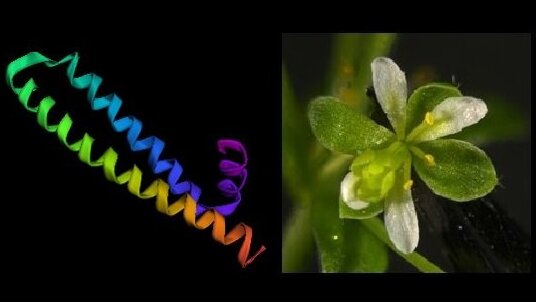
Overview
Phytoplasmas are pathogenic bacteria that are obligate parasites of plants and transmitting insects [1-3]. They can cause devastating plant diseases, e.g. by reprogramming development in a way such that leaf-like structures instead of floral organs occur. Infected plants are thus often sterile, mainly serve to reproduce phytoplasmas and hence have been termed ‘zombie plants' [1, 3]. The molecular mechanism underlying the developmental reprogramming relies on specific interactions of a secreted phytoplasma protein called SAP54 (or PHYLLOGEN1) with a subset of MIKC-type MADS-domain transcription factors involved in controlling flower development [1, 2]. The secreted part of SAP54 interacts with the keratin-like domain (K domain) of MIKC proteins and destines them for degradation [1], so that they cannot constitute ‘floral quartets’ anymore, the protein complexes that specify floral organ identity [4]. Based on the recently published X-ray crystal structure of a K domain and detailed in silico analyses [5, 6] we have developed three hypotheses:
i) SAP54-like proteins form a structure which is very similar to that of the K domain;
ii) The interaction between SAP54 and the plant MIKC proteins is mediated by a mechanism that resembles the interaction of two K domains in floral quartets;
iii) SAP54 mimics the K-domain structure as a result of convergent protein evolution [6].
We want to test these hypotheses by determining the structure of SAP54-like proteins and studying the interaction between these proteins and MIKC proteins.
-
Grant
Project 106 of the International Leibniz Research School (ILRS)
-
Collaborators
This project is realised in cooperation with Matthias Görlach from the Fritz-Lipmann Institute (FLI) in Jena.
-
Suggested Reading
1. MacLean AM, et al. (2014) PLoS Biol 12, e1001835External link
2. Maejima K, et al. (2014) Plant J 78, 541-554External link
3. Du Toit A (2014) Nature Rev Microbiol 12, 393-393External link
4. Gramzow L, Theißen G (2010) Genome Biol 11, 214External link
5. Puranik S, et al. (2014) Plant Cell 26, 3603-3615.External link
6. Rümpler F, et al. (2015) Trends Plant Sci 20, No. 12, 798-806External link